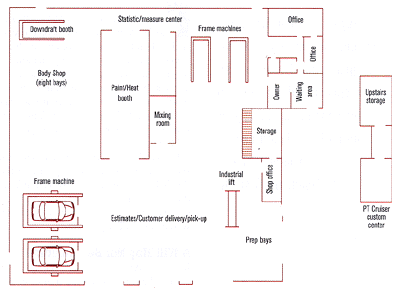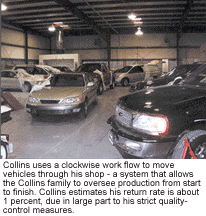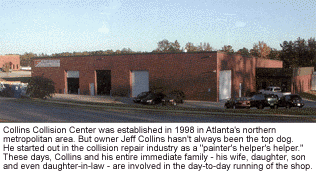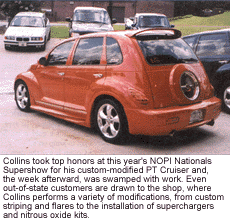|
Shop Name: Collins Collision Center
Cruising Right Along “It changed my life,” Collins says of his Cruiser. “It made me young again.” Good thing, considering that Collins is busy not only with regular repairs, but custom work as well. He’s currently working on the 68th Cruiser brought to his shop for modifications in recent months by owners from seven different states. Recommended by the national PT Cruiser club he belongs to, Collins says owners are willing to stay in a hotel while he works his magic, ranging from custom striping and flares to installing superchargers and nitrous oxide kits. Collins himself has $50,000 invested in his Cruiser, which has become his three-year-old shop’s traveling advertisement. He takes it to car shows throughout the area, where potential customers can “ooh” and “ah” over the $6,000 chameleon paint job, as did the judges of this year’s NOPI Nationals Motorsports Supershow held at the Atlanta Motor Speedway. “I won out of 5,000 vehicles worldwide,” Collins says. “The week after that I was swamped with sales.”
Unique Beginnings The “Collins” in Collins Collision Center is appropriate, considering his entire immediate family is involved in the day-to-day running of the shop, including Collins’ wife, Donna; their daughter, Malena; their son, Billy; and their daughter-in-law, Joann. “The biggest issue is that I control quality better because we’re doing this for a living – it’s our life,” Collins says. “My return ratio right now is probably 1 percent because we’ve got the time to quality control it.” Although Collins’ technicians aren’t family, they’re paid hourly or salary – and they’re paid well, something Collins feels strongly about. “I pay my people high because they’re artistically inclined,” he says. “They don’t mind taking their time [to get a job done right the first time] because they know they’re going to be able to pay their bills this week. “[When a shop owner] pays straight commission, everything’s rush, rush, rush. I still expect rush, but we’ve got the time to slow down and take it properly instead of trying to beat the clock.”
R-E-S-P-E-C-T Collins uses a clockwise work flow to move vehicles through his shop – a system that allows the Collins family to oversee production from start to finish. According to Collins, his shop is also “probably one of the cleanest body shops in the county.” “We steam clean once a week,” he says, adding that benefits far outweigh the cost. “When people walk in your shop and they can eat off the floor – and it’s a body shop – they’re impressed.” But customers weren’t always impressed. Before opening his shop, Collins worked out of a 6,000-square-foot building that wasn’t giving customers the first impression he’d hoped. “I had to kind of sell myself when a customer pulled in, but now when they pull in, they give me immediate respect,” he says, adding that, in return, he does everything he can “to please a customer 100 percent.”
DRP Report: So Far, So Good “I built my shop straight on word-of-mouth and recommendations,” he says, adding that he achieved his enviable sales goal “with no DRP whatsoever.” But Collins felt sales could increase even more by entering into a DRP agreement, so about three months ago, he signed with both Nationwide and State Farm. So far, he says, the relationships have been positive: His business has almost tripled since signing the deals.
“It’s helped tremendously on cash flow,” he says. “Usually, from Nationwide, I’m getting three cars a day in. That’s pretty strong.” Strong enough, in fact, for Collins to set the stage for branching out into another location in the near future. He’s already secured financing to build a second facility from the ground up and is currently negotiating the price of land, located about 10 miles from his current shop. “It’s an auto alley with seven brand-new dealerships,” he says. “No body shops. It’s a gold mine. Somebody’s got to jump on it.” And Collins is just the shop owner to do it.
Writer Debbie Briggs is managing editor of BodyShop Business.
|
Exit Strategies: Personal Vision & Financial Planning
The most critical first step in an exit or transition plan is to develop a financial plan and personal vision of what your life will look like post-business.
Jerry was a 63-year-old auto body shop owner who contacted me regarding putting together an exit strategy. Like most shop owners, he had become tired of the day-to-day grind of dealing with the back-and-forth fights with the insurance carriers, yet he still loved the idea of being a part of a business he built from the ground up. Ideally, he would have liked his production manager, Evan, to become his heir apparent, yet he had no idea if Evan was interested in owning the shop or if he was even capable of doing so. His shop was a prime candidate for a consolidator, and he had received an offer from one, yet he cared about his employees and wanted to make sure they were taken care of. Also, he was unsure what he would do with himself if he did not have a place to go. He did not know where to turn.
Auto Body Shops: Building a Foundation for the New Year
For the new year, it’s important to conduct a thorough audit of your finances to look for areas of opportunity and things to change.

Auto Body Consolidation Update: There’s a New Buyer in Town
The good news for shops that want to sell but do not fit a consolidator’s
profile is that there is a fresh pool of new buyers.

How to Determine the Value of Your Auto Body Shop
Whether you’re looking to sell, expand or transition your shop, understanding the value of your business is essential.

Squad Goals: Empowering Women in Collision Repair
Eight strong, smart, skilled women help Jason Wong guide his two CARSTAR locations in San Francisco.

Other Posts
Collision Repairers: Will You Take the Oath?
Today’s collision repairers are challenged with a new set of concerns, one being the need to follow OEM repair procedures.

Three Generations Keep Trains Running on Time at CARSTAR Jacobus
CARSTAR Jacobus Founder Jerry Jacobus and son Dave share a passion for collision repair and also model railroading.

Auto Body Repair: The Right Way, the Wrong Way and Another Way
In a perfect world, every repairer would make the right decisions in every repair, but we don’t live in a perfect world.

The Digital Blitz
We talk so much about how much collision repair is changing, but so is the world of media!










